Go to All Blogs | Birding Blogs | Birding Asia Blogs | Sulawesi and Halmahera Birding Tours | Indonesia Birding Tours | All our birding tours
Andy Walker reports from Sulawesi.
The island of Sulawesi (formerly Celebes) offers some of the best birding in Indonesia, and that’s saying something for a country made up of over 17,500 islands sprawling across 3,181 miles (5,120 kilometers) from east to west, and 1,094 miles (1,760 kilometers) from north to south, including the ‘famous’ islands of New Guinea (Papua and West Papua), Borneo (Kalimantan), Halmahera, Java, Bali, and Sumatra to name a few, and which has a bird list of nearly 1,800 species!
Sulawesi is quite frankly, a rather odd shape, almost a bit like an octopus with long ‘arms’ reaching out in several directions. Along with Borneo, Sumatra, and Java, Sulawesi is part of the Greater Sunda Islands.
The Sulawesi Archipelago, which includes several near-shore islands such as the Banggai islands – where I visited in February 2020 (read all about the birding on these islands in this blog post), has a bird list of 534 species following International Ornithological Congress (IOC) taxonomy in October 2020 and an amazing 98 endemics, including one endemic monotypic family, the highly sought-after Hylocitrea – making it a ‘must-visit’ destination for ‘family listers’.
Some of the highly sought-after and intriguing species in Sulawesi include Maleo, Geomalia, Malia, Blue-faced Rail, several endemic kingfisher (such as Green-backed Kingfisher, Lilac Kingfisher, Scaly-breasted Kingfisher, Great-billed Kingfisher, and Sulawesi Dwarf Kingfisher), Purple-bearded Bee-eater, Sulawesi Pitta, Sulawesi Hornbill, Knobbed Hornbill, Lompobattang Flycatcher, Sulawesi Streaked Flycatcher, Sulawesi Goshawk, Ashy Woodpecker, and a range of owls and nightjars such as Satanic Nightjar, Sulawesi Nightjar, Ochre-bellied Boobook, Speckled Boobook, Sulawesi Masked Owl, Minahassa Masked Owl, and Sulawesi Scops Owl. There are just so many amazing birds to look for here and this list is just a very small sample, with tons of fruit doves, pigeons, parrots, flycatcher, mynas, thrushes, warblers, white-eyes, and raptors all possible too!
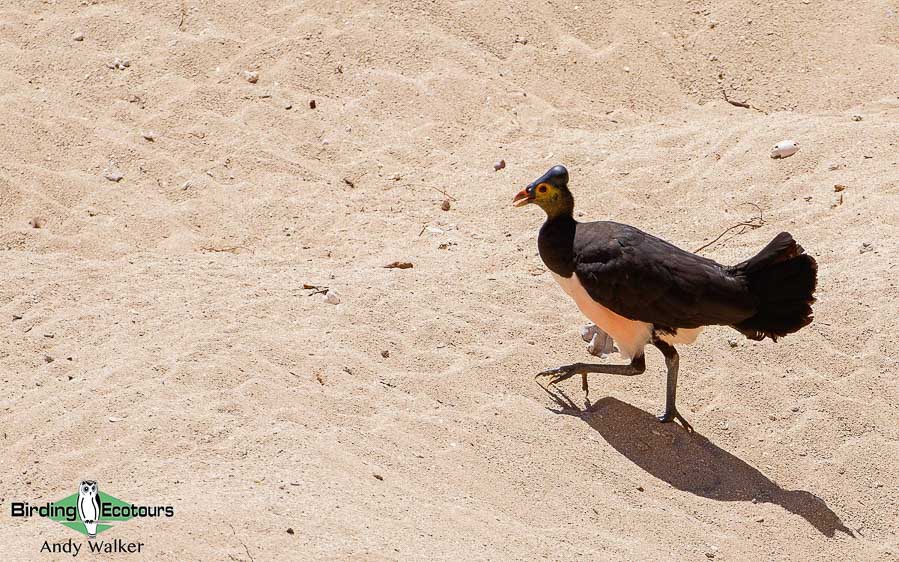 Maleo – always a top target when birding in Sulawesi.
Maleo – always a top target when birding in Sulawesi.
Furthermore, Sulawesi sits in an interesting position geographically, to the east of the Wallace Line – an invisible line that marks the change from Asian fauna (west of the line) to Australian fauna (east of the line). Those countries that occur in the transition zone closest to the Wallace Line (such as Sulawesi) are considered to be part of ‘Wallacea’ – named after Alfred Russel Wallace, a British naturalist (amongst many other things) who discovered this phenomenon whilst independently conceiving the theory of evolution through natural selection in a paper jointly published with some of Charles Darwin’s writings.
We have a really exciting Sulawesi and Halmahera birding tour that I’m lucky enough to lead in July each year with our team of excellent local guides. However, like everyone, we unfortunately had to postpone our 2020 tour due to the ongoing global Covid situation. I have been ‘stuck’ in Bali since March 2020 and in about August 2020, travel within Indonesia was approved (after taking a Covid test and following certain precautions). Once Tangkoko National Park in northern Sulawesi opened to foreigners still in Indonesia, I decided to take the relatively short flight from Denpasar in Bali to Manado in northern Sulawesi to spend a few days exploring this top birdwatching site in Sulawesi.
One of the best things about Tangkoko National Park is that it is packed full of interesting birds, including many of the aforementioned endemics, as well as some unique mammals. In addition to the high-quality wildlife, the open-nature of the forest here, with its limited ground-cover vegetation, offers incredible views of many species, and this also allows for some great photo opportunities, for those that way inclined. Finally, the birds and wildlife here are relatively accustomed to people, far more so than most other places I’ve been in Indonesia (usually they can be nervous due to hunting pressure – either to kill and eat or to capture for the illegal pet trade – unfortunately still a huge problem in the country). All in all, the above results in some of the best birding in the country and is always a popular stop on our tours. Therefore, I felt a long-weekend here and at the nearby Mount Mahawu (for some higher-elevation birds) would be good fun – and I wasn’t disappointed….
Walking through the park entrance we were greeted by the sight and sound of multitudes of pigeons and doves, White-faced Cuckoo-Dove, Grey-cheeked Green Pigeon, Black-naped Fruit Dove, and Silver-tipped Imperial Pigeon to name but a few. It was early morning, and many other species were announcing their presence vocally and flying between roosting and feeding areas which included the rather impressive White-necked Myna dragging its long tail behind – very nice, while on the forest floor a lone Philippine Megapode (Tabon Scrubfowl) skulked about. Our attention was suddenly dragged into the tangles of a tree where we got glimpses of one of the spectacular endemics we were hoping for, Yellow-billed Malkoha. I’d seen this species back in February but only briefly without any photo opportunities, but this one was happy to show well. It was interesting watching it slink around looking for a hearty insect breakfast. Also, in the same tree, a pair of Bay Coucals were similarly working away for some food. The foraging of these two large species had not gone unnoticed, for a Hair-crested (White-eyed Spangled) Drongo was waiting patiently nearby for any insects escaping the malkoha or coucal, as too were Pale-blue Monarchs – clever tactics!
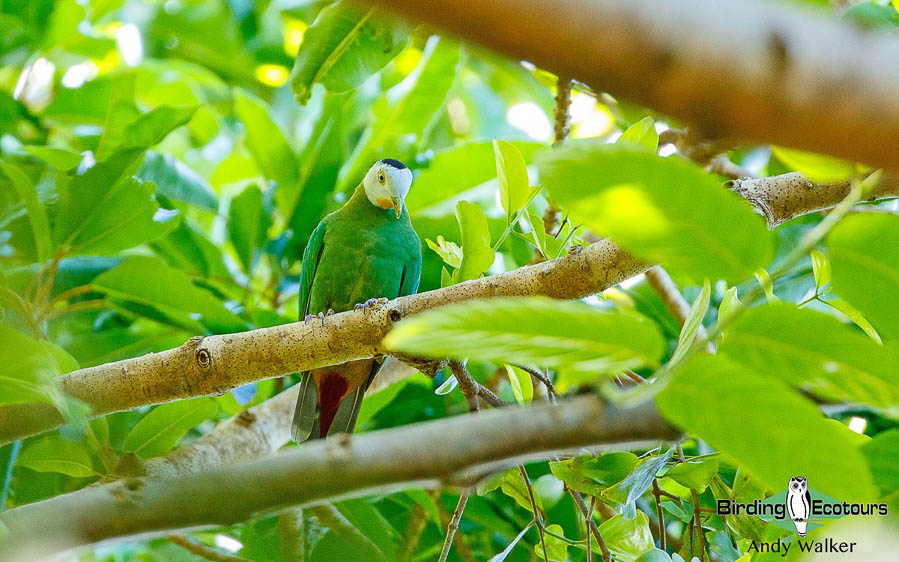
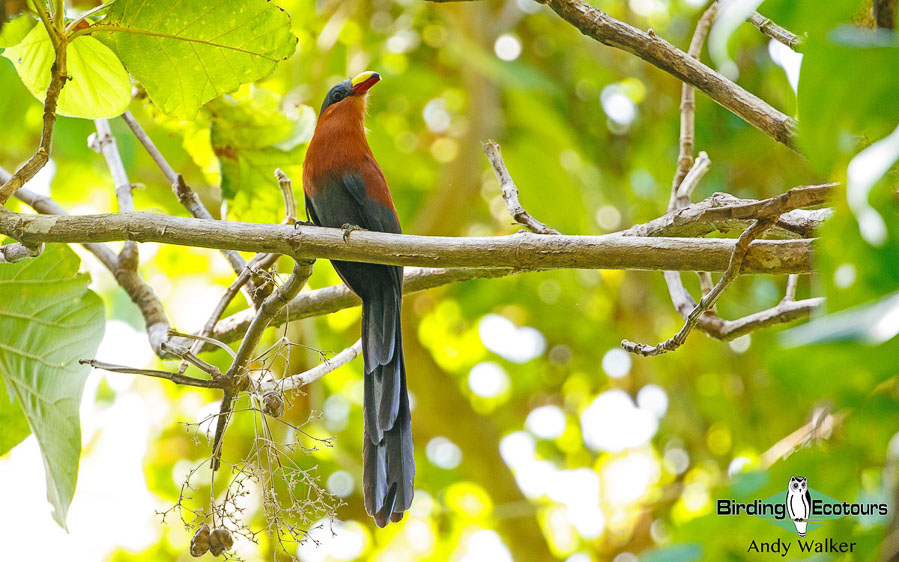
As we approached a small campsite clearing, another of the major target birds appeared into view, Ashy Woodpecker. There are not many woodpeckers to the east of the Wallace Line and this is the largest, it too showed well. Several swiftlets were foraging at different heights in the open area, these included Glossy Swiftlet, Sulawesi Swiftlet, and Uniform Swiftlet, all dwarfed by the huge Grey-rumped Treeswift. There was a very secretive bird calling in the distance, so while waiting for that to come closer, there was ample opportunity to study the swiftlets, always a fun exercise! The secretive bird started getting closer, so we found a more concealed spot and waited, after a lot of cat-and-mouse, eventually a pair of Isabelline Bush-hens stepped into view, showing very well, for bush-hens that is! We were pleased that they did show as there was a lot of bird activity in the nearby trees that deserved some attention as they held Yellow-sided Flowerpecker, Olive-backed Sunbird, Sultan’s (Sulawesi) Cuckoo-Dove, White-faced Cuckoo-Dove, Grosbeak Starling, Sooty-headed Bulbul, and Collared Kingfisher among others already seen.
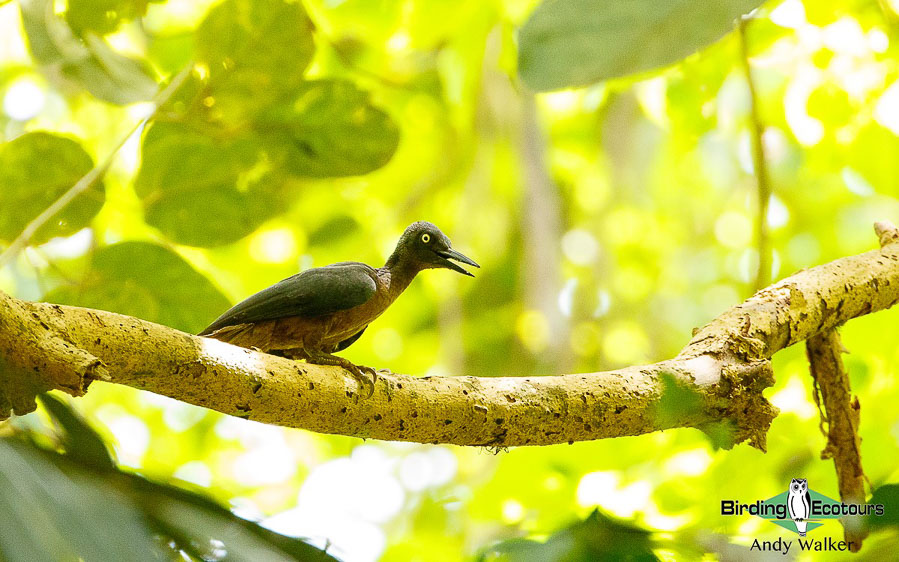
Walking back into the forest there was suddenly a troop of Celebes Crested (Black) Macaques sat in the trail which proceeded to give some great views. It’s always interesting to watch mammals in their natural habitat.
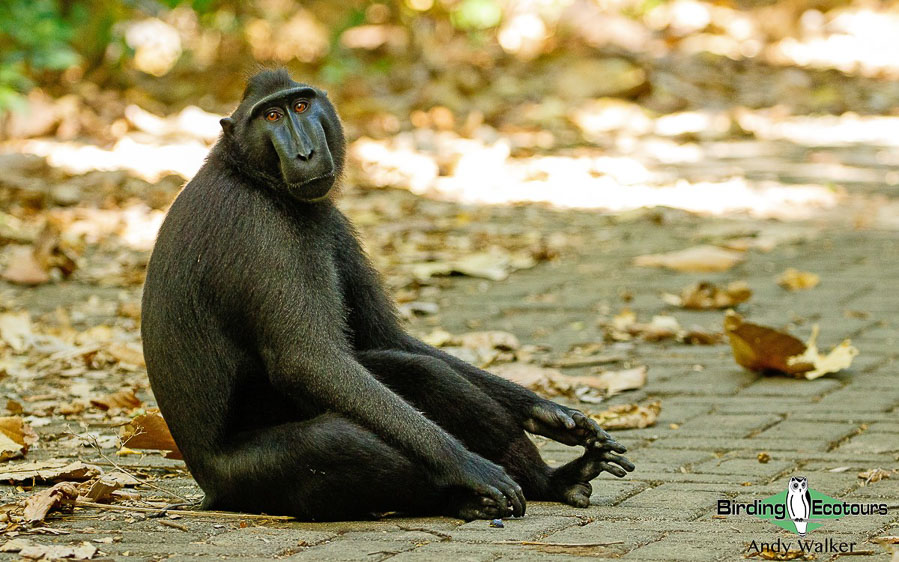
It was shortly after the monkey sighting that the morning hit the jackpot as far as we were concerned, with fantastic, point-blank, walkaway views of both Green-backed Kingfisher and Lilac Kingfisher, two of the most highly sought-after kingfisher endemics. They say a picture paints a thousand words – so here you go!
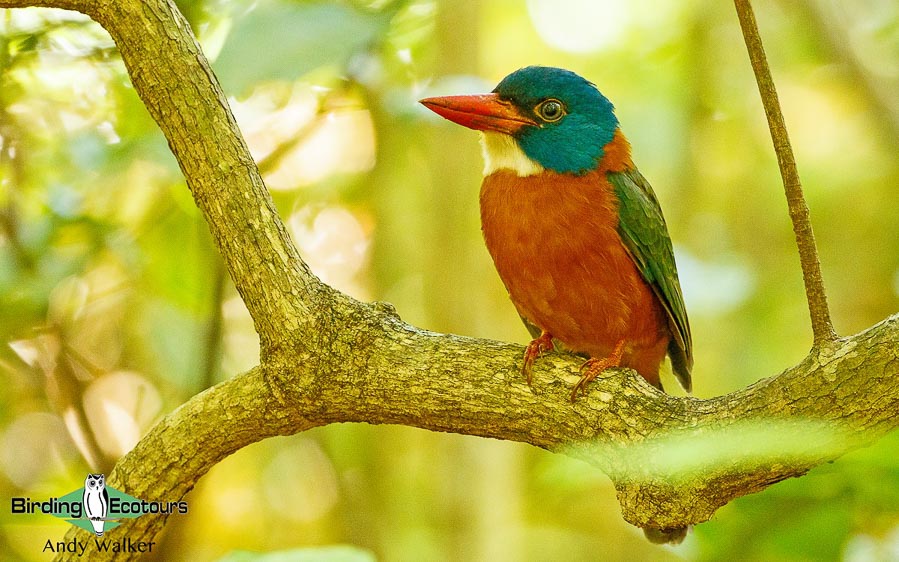
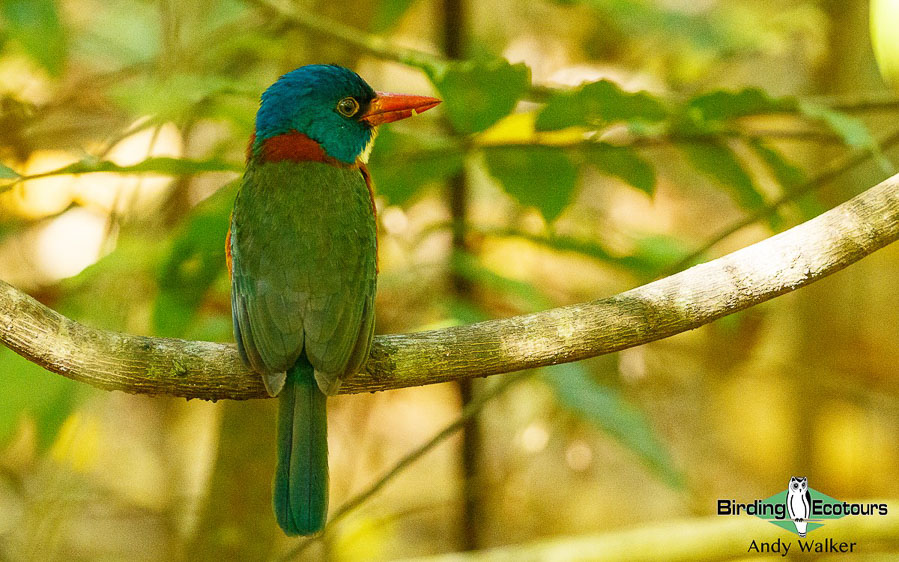
This Green-backed Kingfisher allowed me to do a 360o walk-around as it sat motionless low-down (at eye-level) in the hanging vines – stunning, what a bird! The Lilac Kingfisher a few moments later was just as co-operative…
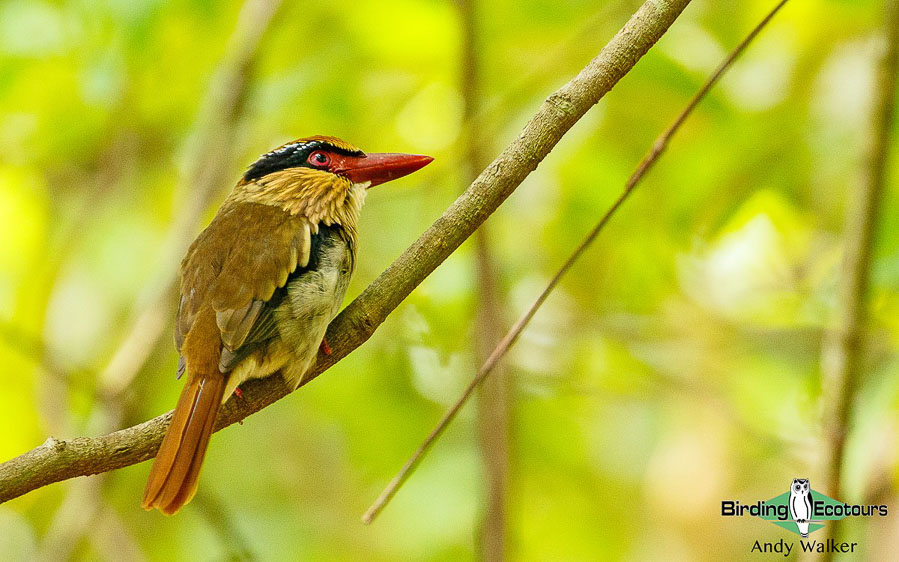
All of the above certainly made for a great first mornings birding!
After a great local-style lunch – amazing fresh fish, and a siesta through the hottest part of the day, it was time for the afternoon birding session. This was almost as good as the morning with further views of many of the birds mentioned above along with yet more highlights found too, such as Sulawesi Hawk-Eagle, Purple-winged Roller, Black-billed Koel, Yellow-breasted Racket-tail, Black-naped Oriole, and two more mammals – Spectral Tarsier and (Sulawesi) Bear Cuscus. As dusk turned into darkness a brief session near the accommodation yielded Sulawesi Nightjar and Great Eared Nightjar. It had been a great day birding in Tangkoko National Park. With so many incredible highlights it was tough to pick a favorite!
The next morning it was time for a bit of a longer hike as we walked along the nice flat trails for quite a way (just stopping for a quick glance at some of the birds mentioned above) before going “off-piste” a little. After a bit of uphill, we reached a tree and sat and waited. We could hear our target bird calling and then flying around behind us – it’s not a quiet bird, and it was coming closer and closer… eventually there it was – right above us. Patiently we remained hidden, the urge to get the camera going was huge but we needed to wait and let it feel comfortable with our presence. After a while of it sitting and preening it eventually did what we hoped it would do…
The simply stunning male Knobbed Hornbill dropped down to the tree in question where it proceeded to regurgitate fruit and feed his partner through a small slit – this was the nest-site of this amazing endemic hornbill and the wait had been more than worthwhile. We enjoyed fantastic views of this remarkable bird, soaking in every minute detail.
To get the view we had of Knobbed Hornbill was beyond our wildest dreams. What a bird!
After the excitement of the hornbill (and there was a lot of it) there was still plenty more to come. We found the endemic Ochre-bellied Boobook roosting low down in some spiky palms and then also found a secretive Red-backed Thrush which nervously showed. Other highlights included Golden-mantled Racket-tail, Blue-backed (Azure-rumped) Parrot, Ornate Lorikeet, Pied Cuckooshrike, Sulawesi Babbler, and numerous Green Imperial Pigeon (e.g. a flock of 30 birds sat in a dead tree!).
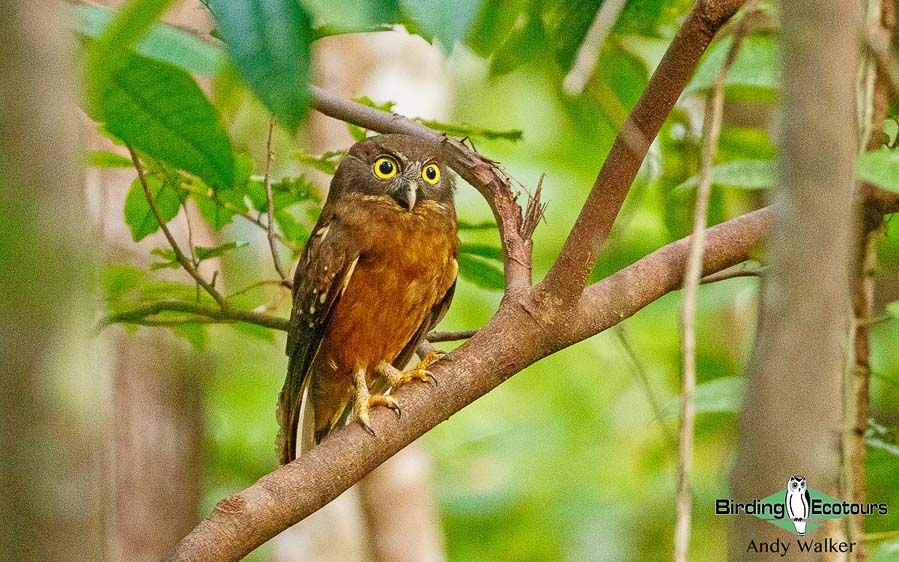
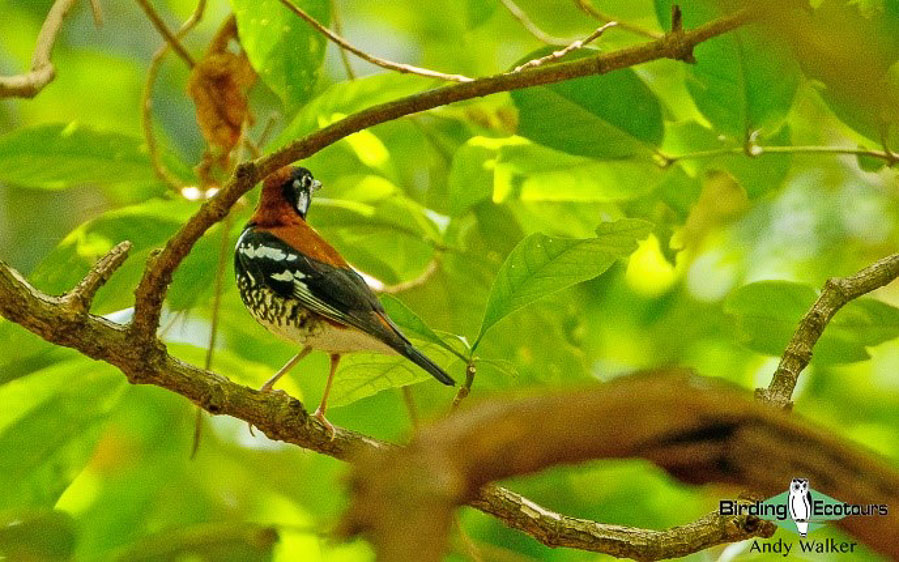
Next up was a boat ride on an outrigger along a river channel surrounded by mangroves. The journey to the river mouth was across a sheltered coastal sea passage which gave good views of Pied Imperial Pigeon, Pacific Reef Heron, and Lesser Frigatebird. On reaching the river mouth, two extremely (and typically) raucous Channel-billed Cuckoos flew over – we could hear them coming from miles away! Striated Heron, Eurasian Whimbrel, and Common Sandpiper greeted us, as too did a pair of smart Collared Kingfisher and a pair of the gorgeous Australian migrant, Sacred Kingfisher.
As we progressed along the river, we found Black Sunbird, Golden-bellied Gerygone, White-breasted Woodswallow, Pink-necked Green Pigeon, Grey-cheeked Green Pigeon, Silver-tipped Imperial Pigeon, Slender-billed (Sulawesi) Crow, and Great (Sulawesi) Hanging Parrot. Our main target bird however took some tracking down, it was very secretive and shy to begin with, but eventually with some patience and excellent boat work, we were able to get into place to enjoy clear views of the huge Great-billed (Black-billed) Kingfisher – yet another Sulawesi endemic. I had seen the red-billed subspecies in February 2020 in central Sulawesi, so it was interesting to see this very different one here. Fantastic views too!
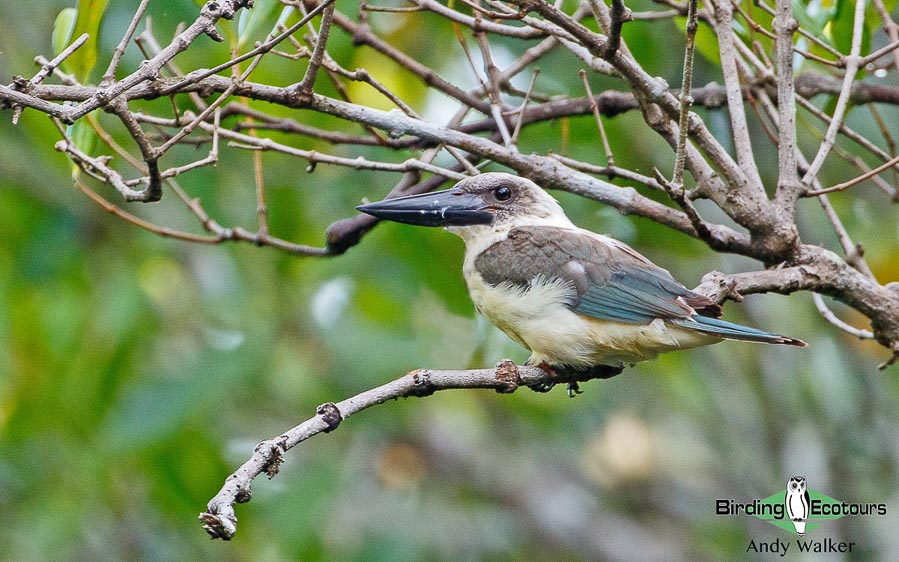
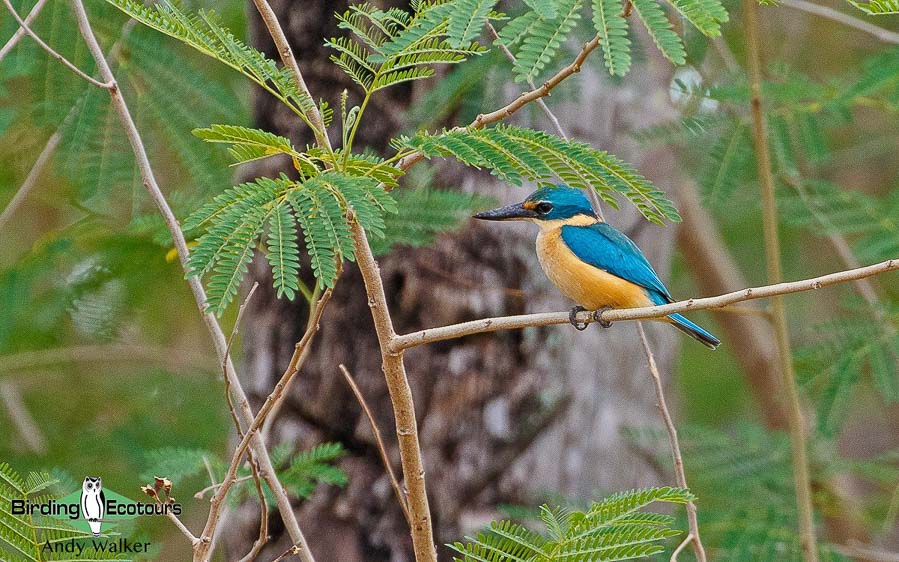
The boat trip rounded off an excellent couple of days in the lowlands of the Tangkoko area and for a final quick stop and change of environment and altitude, we moved across to Gunung Mahawu and the town of Tomohon located nearby (‘gunung’ is mountain in Indonesian).
We stayed in a delightful hotel and had a few fun birds in the garden, such as Sulawesi Scops Owl, Yellow-sided Flowerpecker, Grey-sided Flowerpecker, White-rumped Triller, Black-crowned White-eye, and Warbling White-eye (formerly Mountain White-eye).
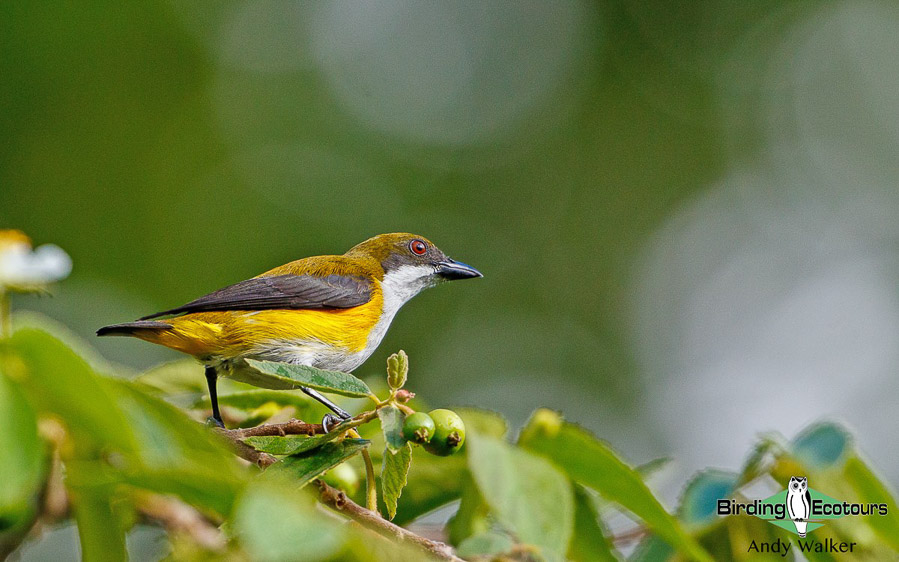
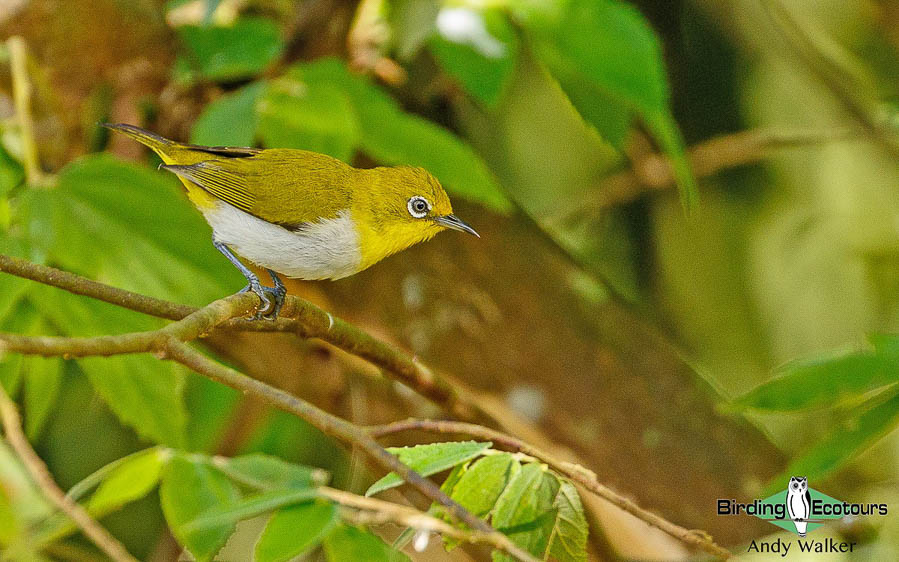
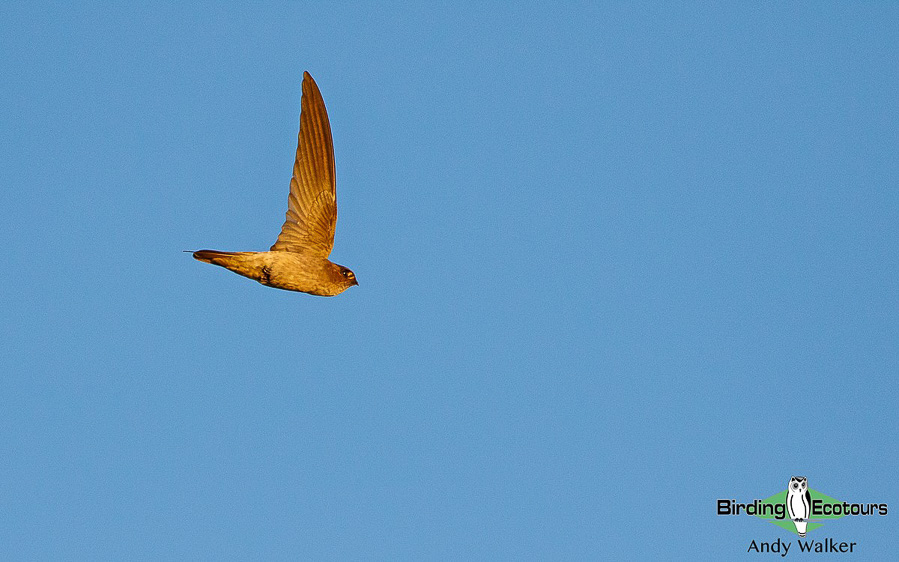
Unfortunately, our morning birding session at Gunung/Mt Mahawu was seriously hampered by rain so we didn’t get the Scaly-breasted Kingfisher that we would usually stand a great chance of seeing here, though consolation in the form of Sulawesi Blue Flycatcher, Citrine Canary-flycatcher, Rusty-breasted Cuckoo, White-bellied Imperial Pigeon, Sulawesi Myzomela, Sulphur-vented Whistler, Sulawesi Bush Warbler, Turquoise Flycatcher, Snowy-browed Flycatcher, and Crimson-crowned Flowerpecker were all welcome.
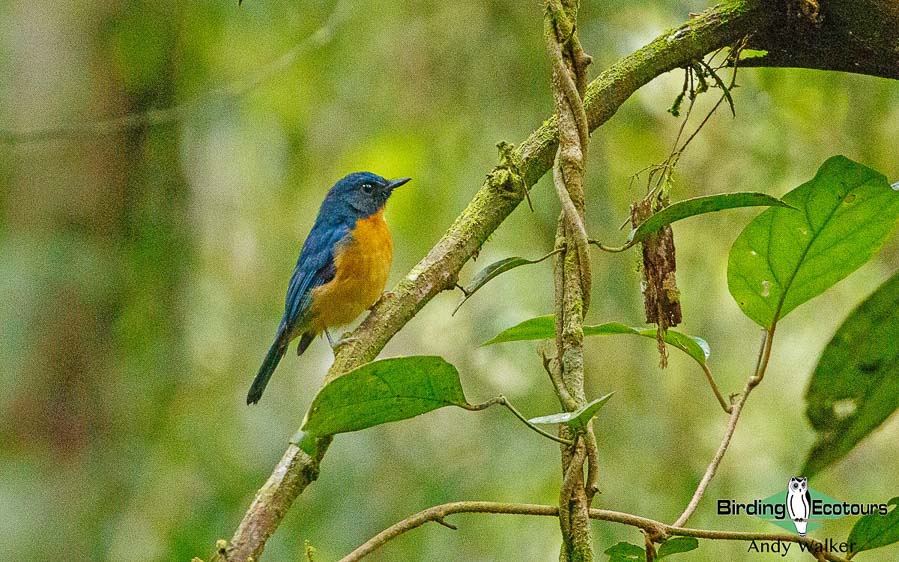
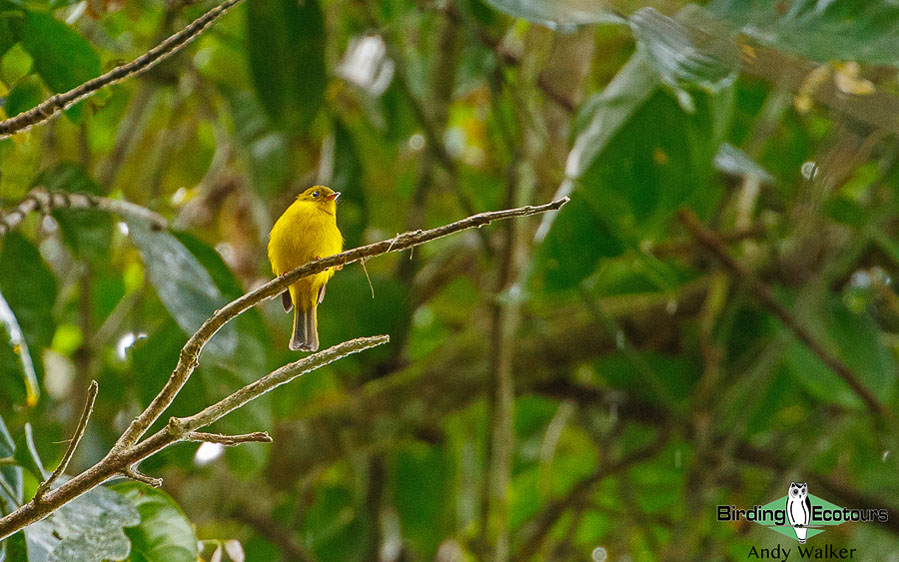
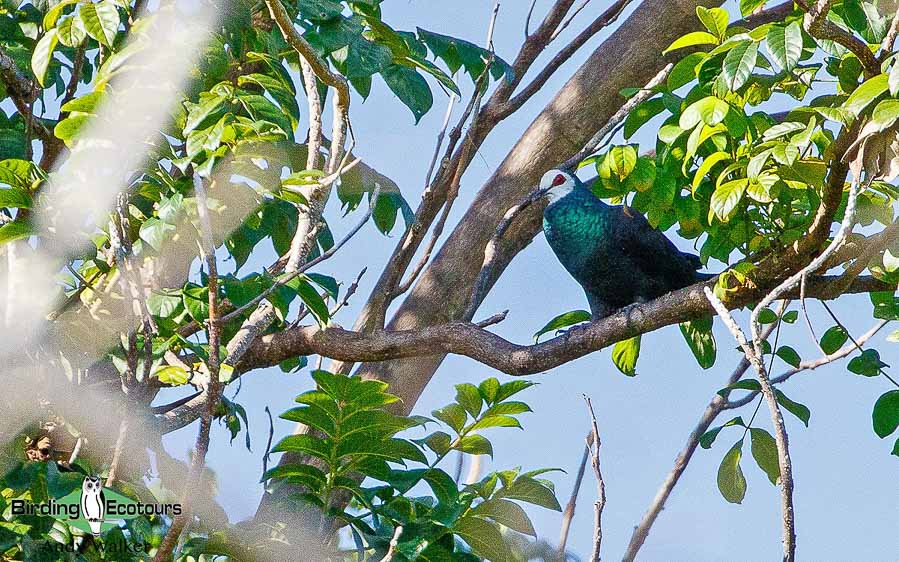
Despite the poor weather we encountered on the mountain, it was still great to be in the forest, with some very nice patches of habitat thankfully still present, despite plenty of deforestation for agriculture clearly evident in the surrounding area.
It is easy to see why this part of Sulawesi, located right at the tip of the Minahassa Peninsula, is so popular with visiting birders and photographers. It is possible to rack up a huge number of Sulawesi endemics in no time at all, and get great views of so many of them. Even in the couple of brief birdwatching sessions we made on this trip, our list was very impressive, and on our Sulawesi bird tour we spend even more time here (summarized above), which will result in even more high-quality birding experiences.
As we were in Manado it seemed like a good opportunity to take the short flight to Ternate in the North Moluccas and hop over to the nearby island of Halmahera… could the birding get even better than in Sulawesi? Find out by reading our new Halmahera blog post here.
Our 2021 Sulawesi and Halmahera tour is a guaranteed departure with a few places left at the time of writing (October 2020), so why not take a look at our freshly updated detailed itinerary here and consider joining us, I’m sure you will have a great time!
